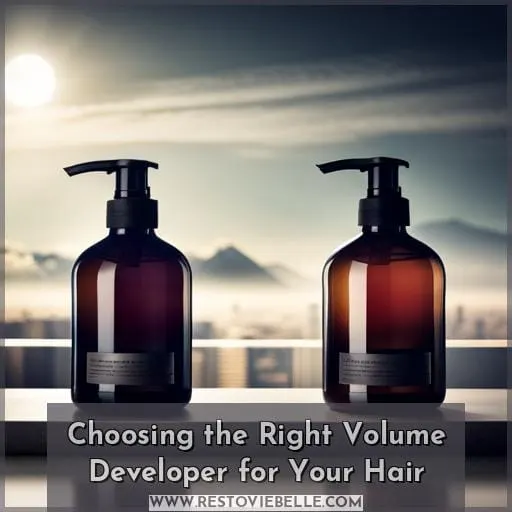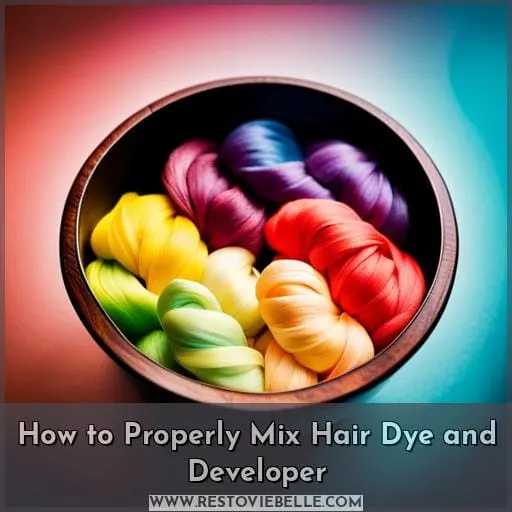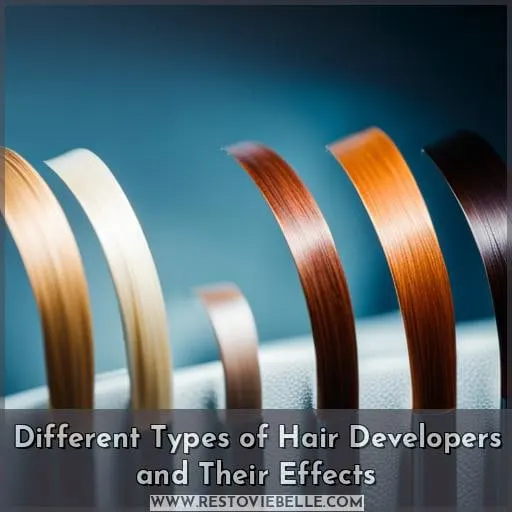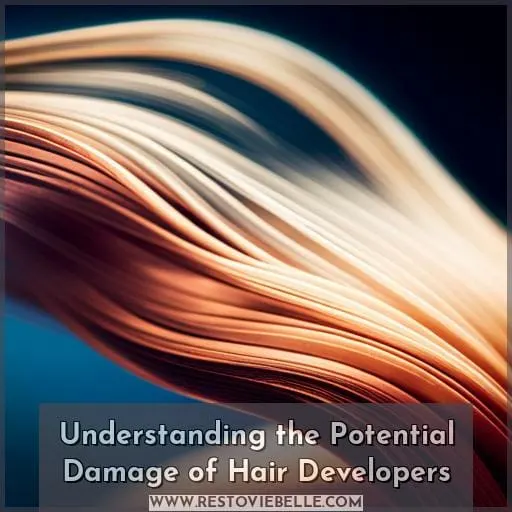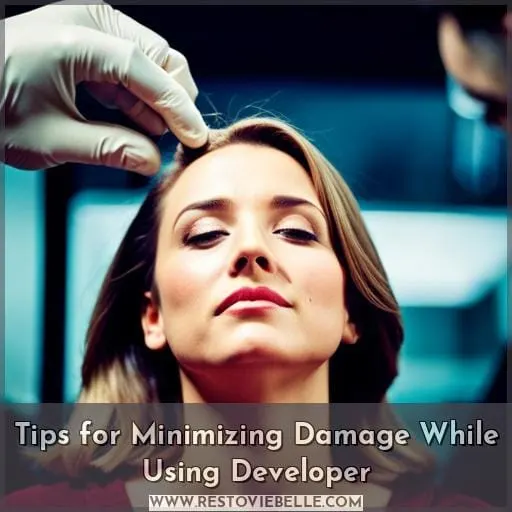This site is supported by our readers. We may earn a commission, at no cost to you, if you purchase through links.
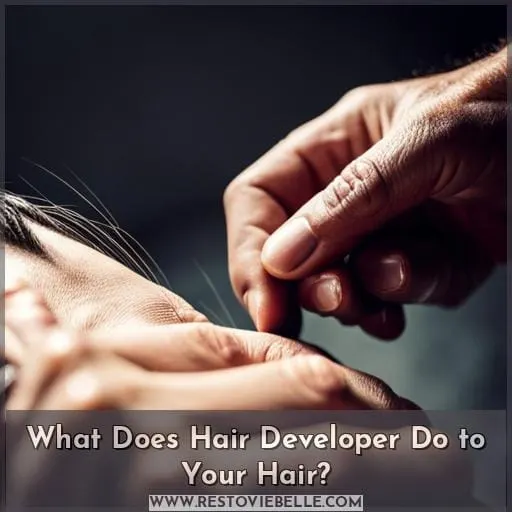 Are you ready to go bold with your hair color? Whether you’re looking for a subtle change or something drastic, make sure that understanding what developer does to your hair is the first step.
Are you ready to go bold with your hair color? Whether you’re looking for a subtle change or something drastic, make sure that understanding what developer does to your hair is the first step.
Developer is essentially hydrogen peroxide, and it works by lifting the cuticle layer of the hair in order to lighten natural pigment. Different strengths can be used depending on whether permanent dye or bleach is being applied.
For fragile baby hairs needing just one level of lift, 5 volume developer is recommended. On the other hand, for 4-5 levels of lift when using high lift colors, 40 volume developer is more suitable.
Knowing how to properly mix developer with dye and which type suits best will help keep damage at bay while achieving beautiful results! Let’s explore how developer affects our locks so we can get salon quality tresses without leaving home!
Table Of Contents
- Key Takeaways
- What is Hair Developer and How Does It Work?
- Choosing the Right Volume Developer for Your Hair
- How to Properly Mix Hair Dye and Developer
- Different Types of Hair Developers and Their Effects
- Understanding the Potential Damage of Hair Developers
- Tips for Minimizing Damage While Using Developer
- Conclusion
Key Takeaways
- Hair developer contains hydrogen peroxide, which lifts the cuticle layer to lighten natural pigment.
- Developer strengths vary for dye and bleach: 5 vol for baby hairs, 40 vol for high lift colors.
- Accurate measurement is crucial for proper mixing; always follow the manufacturer’s instructions.
- Choose developer strength based on lightening/darkening needs: 5 vol for minimal shift, 20 vol for gray coverage.
What is Hair Developer and How Does It Work?
You can create amazing color and lift results in your hair with the help of an oxidant cream containing hydrogen peroxide – known as a Hair Developer! By opening the cuticle layer, it allows color to penetrate deeply.
Depending on the strength of developer used, you’ll experience different levels of cuticle lifting and lightening. Five vol is minimal shift/no lift for semi/demi colors; 10 vol blends gray with permanent color; 20-30 vol works great for gray coverage & powerful bleach applications respectively; 40 Vol lifts 4-5+ levels but should not be used with bleach.
For best results, use branded developers that pair better than generic ones like Eva Professional which are formulated specifically for brand colors providing deeper penetration.
Choosing the Right Volume Developer for Your Hair
Choosing the right volume developer for your hair can be a daunting task. Depending on how much lightening or darkening you want to achieve, as well as the type of color and hair quality you have, selecting an appropriate developer is essential to achieving desired results.
Whether it’s permanent gel color or toner for platinum blonde locks, there are various levels of developers available that will suit different needs.
Degree of Lightening/Darkening
The strength of the developer you choose will determine how much lightening or darkening your hair will experience. A 5 vol developer offers minimal color shift with no lift, while 10 vol provides a moderate amount of cuticle lifting and lightening.
20 vol is standard for gray coverage and up to 3 levels of lift with permanent color; it’s also powerful when used with bleach. For more dramatic lifts, use 30-40 Vol but be aware that this may cause damage to fragile strands.
Developer application techniques are important too – ensure proper measuring, avoid guessing measurements, and follow instructions for each formula and hair type carefully!
Finally, consider specialized products like Hairfall Control shampoo and conditioner after dyeing to maintain healthy hair quality and texture post-application.
Color Type
Choosing the right color type based on your desired lightening or darkening effect is like balancing a tightrope; you must be sure to take each step with precision for the best results. Developer strengths range from 5-40 vol, creating varying degrees of cuticle opening and lift.
Haircare routine post-dye application is essential for damage control and color maintenance. Consider specialized products such as Olaplex treatment, which repairs compromised hair structure. RetroBrite purposes are also possible using 10 vol developer, removing yellowing from plastics in combination with hair colors.
Generic developers can provide good results, but branded ones pair better with specific colors.
Hair Type
It’s important to consider your hair type when selecting the right volume developer, as different levels of strength can provide more or less lift and color shift.
For instance, 10 vol is great for fragile hair since it has minimal lightening and lifting power. On the other hand, 20 vol works effectively on gray coverage with permanent color. If you’re looking for 3+ level lifts with permanent colors, 30 vol provides ideal results.
However, it’s best to avoid using 40 vol due to its high oxidation levels, which may cause damage if used improperly.
To minimize any potential damages, always follow instructions from the manufacturer closely. Additionally, use lower volumes when applying toner/glaze to maintain base color. Make sure to wear gloves and ensure proper ventilation during the application process.
It’s also recommended to perform a patch test before full application if required.
By carefully considering your own specific needs and following the guidelines given by professionals, you can safely obtain the desired outcomes without experiencing any damaging effects from post-dyeing treatments.
Hair Quality
When selecting a volume developer, consider the quality of your hair to ensure you achieve optimal results. Hair strength and resilience determine how well it can handle the hydrogen peroxide in the developer formula.
Fine or brittle hair requires lower volumes for less damage, while thick and coarse locks may tolerate higher levels of lift and color deposit from permanent dyes.
Texture is also important. Is your hair curly, wavy, or straight? All these factors play into whether a particular product is right for you.
To maintain healthy hair with minimal damage after dyeing, use specialized products like Hairfall Control shampoo/conditioner that are free from harsh chemicals found in most drugstore brands.
Balance safety with the desired outcome by choosing wisely – your gorgeous tresses will thank you!
How to Properly Mix Hair Dye and Developer
Properly mixing hair dye and developer is crucial for achieving the desired results. To ensure a successful application, it is important to measure correctly and mix thoroughly.
Step 1: Measure Correctly
Accurately measuring the amount of developer you need is critical for achieving your desired hair color results. Whether it’s 5 vol, 10 vol, 20 vol, or higher, precise mixing and application are essential to maintain healthy hair.
When using peroxide-based products such as bleach or dye, make sure that all measurements are accurate. Even a small difference can lead to undesired results. To prevent damage and keep up with color maintenance post-application, follow instructions closely.
This includes proper timing and using specialized haircare products like shampoo and conditioner designed specifically for colored hair.
Step 2: Mix Thoroughly
Once you’ve measured the hair dye and developer, it’s time to mix them thoroughly. Combine both components at a 1:1 ratio in a plastic container or bowl. Use only metal mixing tools like spatulas and spoons to avoid damaging the cuticle layer of your hair.
For best results when using bleach products such as 10 volume developer or higher concentrations (20-40 vol), use two separate containers. This way, each component can be mixed separately before being integrated into one combined mixture.
Make sure to thoroughly blend at every step, from measuring to final application. Improper mixing can result in uneven coloration and other problems during processing.
Different Types of Hair Developers and Their Effects
Choosing the right developer can help you achieve your desired results while keeping your hair healthy and strong.
- Effects of Developers
- Developer Strengths
- Developer Types
- Developer and Hair Health
- Application Tips
For minimal color shift with semi/demi-color, 10 Volume is suitable. If you’re looking for gray coverage or lift with permanent color, 20 Vol is ideal. However, if you want to lift your hair by 3 or more levels, 30 Vol can do the job, but it comes with a risk of damage.
On the other hand, 40 Vol can lift your hair by 4-5 or more levels, but it’s not recommended for bleach use.
While generic developers can work, branded ones tend to pair better in terms of penetration. For example, Eva Professional’s formula pairs best with their brand’s colors specifically to ensure a proper application process.
It’s also important to consider hair health when choosing a developer. Using the right developer can help maintain the health and strength of your hair.
When applying the developer, always follow the instructions from the manufacturer’s guidelines carefully. This will ensure that you achieve the desired results and avoid any disappointment. Additionally, it’s important to take safety precautions, such as wearing gloves, before using any type of product on the scalp area.
By considering these factors and following the proper application techniques, you can achieve the best results with your hair developer.
Understanding the Potential Damage of Hair Developers
It’s important to understand the potential damage that hair developers can do to your hair. Applying developer is a process that involves opening up the cuticle layer of your strands, allowing color or lightening agents to penetrate deeply and lift your natural pigment.
This means that it has the power to both enhance and damage our locks if not used properly.
Whether you’re using permanent color or bleach, always use lower volumes when applying toner/glaze to protect against base shifting and gray blending. 10 vol strength is recommended for this purpose. For scalp bleach application, 20 Vol is often considered the safest choice.
Additionally, ammonia-based formulas are known oxidant creams containing hydrogen peroxide, which could potentially lead to skin reactions. We recommend doing a patch test before full application to minimize any risks involved further down the line.
Tips for Minimizing Damage While Using Developer
When it comes to hair coloring, using a developer can help you achieve the perfect look. However, to minimize damage while using a developer, make sure to choose low-volume developers and use Olaplex treatment products for the best results.
Choose Low Volume Developers
For minimizing damage, opt for low volume developers such as 10 or 20 vol to get the desired result without compromising hair health.
Low volume benefits include allowing color to penetrate more deeply, minimal cuticle lifting, and lightening with semi/demi color applications, and gray blending.
Depending on your desired look, you can choose from a range of permanent hair coloring options that are compatible with 5-20 vol developer strengths.
For added safety measures, when using higher volumes like 30-40 vol, bleach is not recommended on the scalp due to increased heat generation which can cause damage.
With proper measuring techniques and regular conditioning post-dye application, you’ll be able to enjoy vibrant colored hair while ensuring its health in the long run!
Use Olaplex to Counteract Effects
To combat the damage that can occur when using a developer, consider incorporating Olaplex Hair Perfector Treatment into your hair care routine. This revolutionary product repairs and strengthens damaged strands while protecting hair structure.
It’s easy to use alongside color formulas for gray coverage or toner applications, leaving hair feeling soft and silky. Regular conditioning post-dye application also aids in damage control and helps maintain healthy colored locks! Utilizing this treatment is an excellent way of counteracting any negative effects from a developer while ensuring you get the desired results without compromising on hair health.
Conclusion
It’s clear that hair developer can be a great tool for achieving the perfect look, but it’s important to consider the potential damage it can cause. According to the American Academy of Dermatology, over half of women who dye their hair experience some degree of scalp irritation.
To minimize the risk of damage, it’s important to use the correct volume of developer, mix it properly, and use protective products like Olaplex.
By following these guidelines, you can get the perfect hair color without compromising the health of your hair. Ultimately, understanding and respecting the power of the product is key to achieving great hair with hair developer, so you can make the most out of the desired results.


